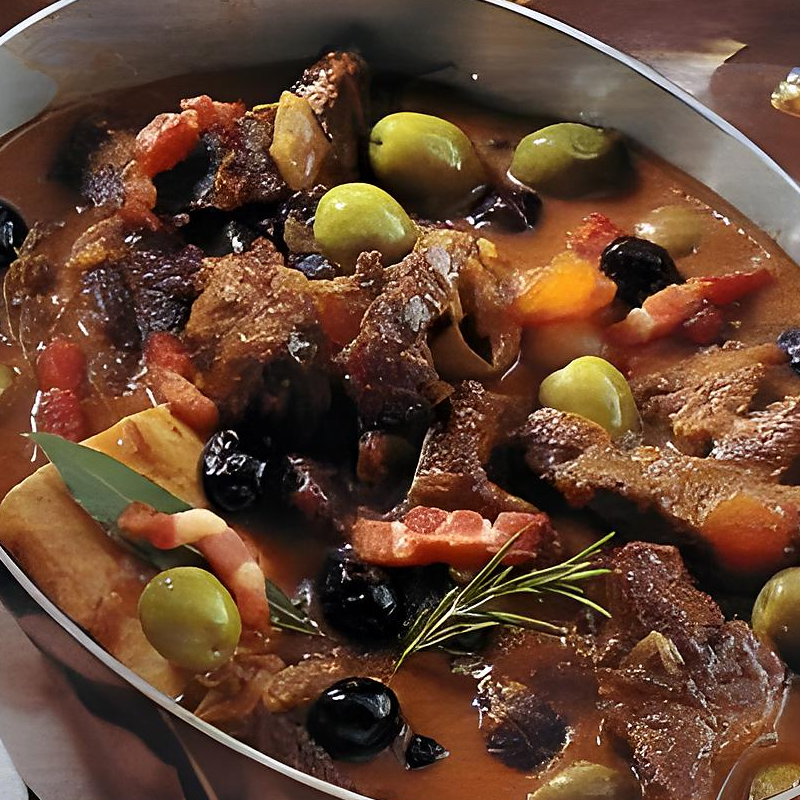Provencal Beef Stew (Estouffade de Bœuf à la Provençale)
 Garanties sécurité
Garanties sécurité
(à modifier dans le module "Réassurance")
 Politique de livraison
Politique de livraison
(à modifier dans le module "Réassurance")
 Politique retours
Politique retours
(à modifier dans le module "Réassurance")
Traditional Recipe for Beef Stew Provençale (Old-Fashioned Style) - Estofat de Boví a la Provençala
Beef Stew Provençale: Origins and First Written Recipe
The Beef Stew Provençale is a traditional dish with roots in the cuisine of Provence in southern France, a region rich in Mediterranean flavors and influenced by diverse cultures. This dish embodies the spirit of Provençal cooking, which favors simple yet flavorful ingredients, often slow-cooked to release their full aromatic richness.
Origin of the Dish
"Estouffade" is a term derived from the word "estouffar," which means "to suffocate" in Occitan, a language still spoken in the south of France. This term refers to the slow-cooking method in which ingredients are braised gently in a liquid, often wine, allowing the meat to become tender and flavorful.
Provence, with its Mediterranean climate, aromatic herbs (such as thyme, rosemary, and lavender), high-quality olive oil, and fresh vegetables, is the perfect birthplace for this kind of recipe. The Beef Stew Provençale is a perfect reflection of the region’s culinary values, combining simplicity, seasonal local products, and careful long preparations.
First Written Recipes
The earliest written traces of the Beef Stew Provençale recipe date back to the late 19th century, when regional Provençal cuisine began to be compiled into cookbooks. While the dish had been prepared in a traditional way for much longer, it is in books such as La Cuisine Provençale or Martha Stewart’s works on Mediterranean cuisines that detailed descriptions of this recipe, with regional variations, began to appear.
There are numerous variations of the stew, which may slightly differ from family to family, but the central element remains beef cooked slowly in a rich red wine broth, enhanced with vegetables, herbs, tomatoes, and fruits like orange for a touch of acidity.
Traditional Recipe for Beef Stew Provençale (Old-Fashioned Style)
Ingredients:
- 2 kg beef (ideally from chuck, round, or brisket, cut into medium-sized pieces)
- 150 g salted bacon (or smoked bacon)
- 2 sliced onions
- 4 to 5 carrots, cut into rounds
- 4 to 5 crushed garlic cloves
- 2 peeled fresh tomatoes (or 400 g canned peeled tomatoes)
- 2 bouquet garni (rosemary, bay leaves, thyme)
- 1 large glass of full-bodied red wine (e.g., Côtes du Rhône or a regional wine)
- 1 large glass of meat broth (preferably homemade, otherwise, a good quality bouillon cube)
- Olive oil for cooking
- Salt and pepper to taste
- 1 chicken carcass (optional but used to enrich the broth, especially in older recipes)
- 1 small orange (zest or pieces, to add a touch of freshness)
- 1 tablespoon flour (optional, to slightly thicken the sauce)
- 1 or 2 potatoes (optional, but can be added to make the dish more hearty)
Traditional Preparation:
Preparing the Meat:
- In a large cast-iron casserole, heat olive oil and brown the beef pieces on all sides to ensure they are well-colored.
- Once browned, remove the meat from the casserole and set aside.
Cooking the Vegetables:
- In the same casserole, add the sliced onions and carrots. Sauté for a few minutes until the vegetables are tender and lightly browned.
- Add the crushed garlic and cook for another minute to release its aroma.
Stewing the Meat and Vegetables:
- Return the browned beef pieces to the casserole and add the peeled tomatoes (or canned tomatoes). Mix well.
- Add the bouquet garni and the orange (either zest or a few pieces for a light but distinct aroma).
- Pour in the red wine and meat broth to cover the meat and vegetables.
- Season with salt and pepper to taste.
Slow Cooking:
- Cover the casserole and let it simmer on very low heat for 2 to 3 hours, ensuring the meat becomes tender and the sauce thickens. You may need to add water or more broth if necessary.
- If using a chicken carcass, add it now to enrich the broth and deepen the flavor.
- If desired, you can add a tablespoon of flour to the sauce near the end of cooking to slightly thicken it.
Option of Potatoes:
- If you wish to add potatoes, peel and cut them into pieces, then incorporate them into the casserole about half an hour before the end of cooking. They will absorb the flavors of the broth and make the dish more filling.
Serving:
- Once the meat is tender and the sauce has reduced, remove the bouquet garni and serve the stew with steamed potatoes, homemade mashed potatoes, or rustic bread to accompany the flavorful sauce.
Characteristics of the Traditional Recipe:
- The long, slow cooking is essential to making the meat tender and allowing the flavors to blend perfectly.
- The chicken carcass, while not essential, was often added in older recipes to enrich the taste of the broth.
- Full-bodied red wine and meat broth bring depth to the sauce.
- The orange, or its zest, is a distinctly Provençal touch that adds a slightly tangy and sweet fragrance, particularly in older recipes where Provençal cuisine was influenced by the region's citrus cultivation.
Conclusion
This revised recipe includes all the essential ingredients and steps for a traditional Beef Stew Provençale, with slow cooking that makes the meat extremely tender while absorbing the flavors of the broth and vegetables. It reflects the richness and simplicity of ancient dishes, often prepared in large cast-iron casseroles to feed an entire family.
There are several variations of Beef Stew Provençale, which can differ depending on the region, personal preferences, or even the season. These variations primarily affect the ingredients, but the principle of slow cooking and braising in rich wine remains constant.
Common Variations of Beef Stew Provençale:
-
White Wine Version: In some regions of Provence, it is common to use white wine instead of red for cooking the stew. This version is lighter and highlights the vegetables and fresh herbs, with white wine pairing especially well with smoked bacon and mushrooms.
-
Seasonal Vegetable Version: Depending on the season, vegetables can be modified. For example:
- Root vegetables like turnips or parsnips can replace carrots.
- Zucchini or eggplant can be added during cooking for a more summery flavor.
- In autumn, some add wild mushrooms or chestnuts to enrich the recipe with woody flavors.
-
Herb Variations: The basic bouquet garni generally includes rosemary, bay leaves, and thyme. However, in some versions, other herbs typical of Provence can be added:
- Sage, which adds a slightly bitter and fragrant touch.
- Lavender, for a more floral Provençal note (but should be used sparingly).
- Basil, which can be added at the end of cooking for a fresh, herby taste.
-
Olives and Citrus Version: Some variants increase the quantity of olives, using green, black, or mixed olives, to emphasize the salty Mediterranean flavor. Additionally, instead of orange, other versions may use lemon or grapefruit zest to add a more pronounced tang.
-
Mixed Meats Version: While the most traditional version uses beef, it is also common to incorporate other meats in the stew, such as:
- Lamb: Very common in southern France, where lamb is often used in stews.
- Pork: Especially in neighboring regions, it can be mixed with beef for a richer and more flavorful version.
-
Honey or Brown Sugar Version: In some sweet-salty versions, a bit of honey or brown sugar is added to the sauce at the end of cooking. This creates a balance between the salty flavors of olives, capers, and bacon, and the sweetness of honey, which is typical of some older Provençal recipes.
-
Anchovies and Tomatoes Version: In more traditional variants, anchovies are cooked with the meat and vegetables to melt into the sauce, giving a unique salty flavor to the stew. The amount of tomatoes may vary depending on the version, but one variant uses more dried tomatoes or tomato paste for a richer and more concentrated sauce.
-
Old-Fashioned Version: A more rustic version of the stew follows the historical recipes, using a cast-iron casserole or a tagine for slow-cooking the meat. Some versions add white beans or chickpeas to make the dish heartier, especially for festive occasions.
-
Different Alcohol Variants: Instead of brandy, some prefer to use other types of alcohol to deglaze and marinate the meat, such as:
- Armagnac
- Rum
- Calvados (especially in the northern Provence regions)
Conclusion:
Beef Stew Provençale can easily be adapted based on personal tastes and local products. Whether changing the wine, adding more vegetables, or incorporating different herbs and spices, each region and family has its own variations of this iconic dish. What remains constant is the slow cooking process and the marriage of rich flavors, making the stew a comforting and savory dish, symbolic of southern French cuisine.


